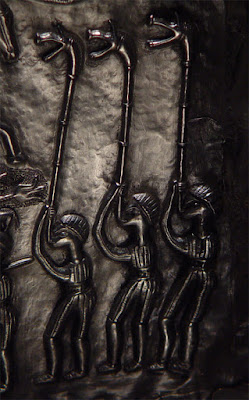My previous illness has made me more determined than ever to enjoy the many treasures and surprises on my doorstep. It's very easy to think of reasons why I don't want to get on a train or tube on my days off, but yesterday I was keen to use my time doing something different. I got up early and enjoyed a sit in the Winter sunshine in Bloomsbury Square, then used my National Art Pass at the British Museum to see the exhibition Celts: Art and Identity. "Celts" encompasses many different people, a cultural label rather than ethnic identity. The term Keltoi was first used around 500 BC by the ancient Greeks to refer to people (uncivilized barbarians, according to them) living north of the Alps. There are none of their own written records and were disparate groups who shared stylised art distinctly different from that of Mediterranean people. Much later people from modern Celtic nations adopted the name to emphasise their distinct identities (e.g. Welsh, Irish, Scottish, Cornish, Brittany, Manx etc.) I found the exhibition very interesting and absorbing; soft music plays in the background and there was quite a hush in the halls, although it was fairly crowded (it finishes on 31st Jan). The first beautiful object you see is a rare ancient Scottish clàrsach (harp), intricately carved from hornbean in a case carved to match.
I loved all the animal and fantastical beast-inspired designs - the boar is particularly prevalent, on shields, brooches and coins, also birds, horses, dragons.
Iron-Age Boar ornament, possibly from a helmet. c.100 BC - AD 100, Norfolk
Photo: © Norwich Castle Museum and Art Gallery
I like that a few of the amazing finds are from Wandsworth and Battersea - apparently, this part of the Thames was a popular place to throw your offerings in the water (plus ça change!)
The Battersea Shield, Iron Age, c.350-50 BC © The Trustees of the British Museum
Bronze Waterloo Bridge Helmet (on left; ceremonial), c. 150-50 BC
Another stunning display features a hoard of 4 gold torcs (300-100 BC) found at Blair Drummond in Sterling by a metal detectorist on his very lucky first outing. Interestingly the skilled workmen demonstrated familiarity with foreign Mediterranean styles. The Snettisham Hoard is even more amazing, a total of around 70 complete torcs with many other broken pieces (c. 70 BC).
The Snettisham Hoard
I really loved learning about the carynx - a serpentine trumpet with a boar's head which accompanied warriors into battle (you can listen to a replica through an earpiece next to it).
These figures, depicted on the Gundestrup cauldron, are playing the carynx
One of the most striking objects in the exhibition is the Silver Gundestrup cauldron (c.100 BC, found in Nothern Denmark). It is thought to have been made in Bulgaria, although this is debated. The vessel is richly decorated with numerous ritual and mythological scenes of Gods and fantastic animals. See this link for further details. It is described by the museum as being one of the most important and intriguing finds from ancient Europe.
Gundestrup Cauldron
For other reviews, have a look at these links:
http://www.theguardian.com/artanddesign/2015/sep/22/celts-art-identity-review-unintentional-resurrection-jonathan-jones
Apologies for the annoying background to some of the text; still learning!
Apologies for the annoying background to some of the text; still learning!










